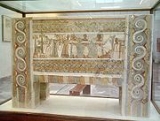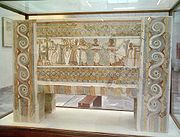
Hagia triada
Encyclopedia
Hagia Triada is the archaeological site of an ancient Minoan
settlement. Hagia Triada is situated on a prominent coastal ridge, with the Mesara Plain
below. Hagia triada sits at the western end of the ridge, while Phaistos
is at the eastern end. Hagia Triada means holy trinity in Greek.
, situated at the western end of the Mesara Plain
. The site was not one of the "palace
s" of Minoan Crete, but an upscale town, and possibly a royal villa. After the catastrophe of 1450 BC, the town was rebuilt and remained inhabited until the 2nd century BC. Later, a Roman period villa was built at the site. Nearby are two chapel
s, Agia Triada and Agios Georgios
, built during the Venetian
period, as well as the deserted village
of Agia Triada.
 Hagia Triada, as nearby Phaistos
Hagia Triada, as nearby Phaistos
, was excavated from 1900 to 1908 by a group from Italian Scuola Archeologica Italiana di Atene, directed by Federico Halbherr
and Luigi Pernier
. They unearthed a sarcophagus
painted with illuminating scenes from Cretan life, now at the Archaeological Museum in Iraklion.The sarcophagus was used for the burial of a prince during the period of the Mycenean occupation (1400 BC).The main scene is a bull sacrifice and shows all the stages of the sacred ceremony. On it appear a large number of religious symbols,a male figure playing a flute and a man playing a seven-string lyre.This is the oldest picture of the lyre known in classical Greece.
The site includes a town and a miniature "palace", an ancient drainage system servicing both, and Early Minoan tholos
tombs. The settlement was in use, in various forms, from Early Minoan I until the fires of Late Minoan IB
.
Hagia Triada has yielded more Linear A
tablets than any other Minoan
archaeological site. Other famous finds include the Chieftain's Cup, the Boxer Vase, and the Harvest Vase.
Minoan civilization
The Minoan civilization was a Bronze Age civilization that arose on the island of Crete and flourished from approximately the 27th century BC to the 15th century BC. It was rediscovered at the beginning of the 20th century through the work of the British archaeologist Arthur Evans...
settlement. Hagia Triada is situated on a prominent coastal ridge, with the Mesara Plain
Mesara Plain
The Mesara or Messara Plain is an illuvial plain in southern Crete, stretching about 50 km west-to-east and 7 km north-to-south, making it the largest plain in Crete....
below. Hagia triada sits at the western end of the ridge, while Phaistos
Phaistos
Phaistos , also transliterated as Phaestos, Festos and Phaestus is an ancient city on the island of Crete. Phaistos was located in the south-central portion of the island, about 5.6 kilometres from the Mediterranean Sea. It was inhabited from about 4000 BC. A palace, dating from the Middle Bronze...
is at the eastern end. Hagia Triada means holy trinity in Greek.
Geography
Hagia Triada is in south central Crete, 30-40 meters above sea level. It lies four km west of PhaistosPhaistos
Phaistos , also transliterated as Phaestos, Festos and Phaestus is an ancient city on the island of Crete. Phaistos was located in the south-central portion of the island, about 5.6 kilometres from the Mediterranean Sea. It was inhabited from about 4000 BC. A palace, dating from the Middle Bronze...
, situated at the western end of the Mesara Plain
Mesara Plain
The Mesara or Messara Plain is an illuvial plain in southern Crete, stretching about 50 km west-to-east and 7 km north-to-south, making it the largest plain in Crete....
. The site was not one of the "palace
Palace
A palace is a grand residence, especially a royal residence or the home of a head of state or some other high-ranking dignitary, such as a bishop or archbishop. The word itself is derived from the Latin name Palātium, for Palatine Hill, one of the seven hills in Rome. In many parts of Europe, the...
s" of Minoan Crete, but an upscale town, and possibly a royal villa. After the catastrophe of 1450 BC, the town was rebuilt and remained inhabited until the 2nd century BC. Later, a Roman period villa was built at the site. Nearby are two chapel
Chapel
A chapel is a building used by Christians as a place of fellowship and worship. It may be part of a larger structure or complex, such as a church, college, hospital, palace, prison or funeral home, located on board a military or commercial ship, or it may be an entirely free-standing building,...
s, Agia Triada and Agios Georgios
Agios Georgios
There are many places and churches that have the name Agios Georgios :-In Cyprus:*Agios Georgios, Famagusta , near Trikomo, Cyprus...
, built during the Venetian
Republic of Venice
The Republic of Venice or Venetian Republic was a state originating from the city of Venice in Northeastern Italy. It existed for over a millennium, from the late 7th century until 1797. It was formally known as the Most Serene Republic of Venice and is often referred to as La Serenissima, in...
period, as well as the deserted village
Ghost town
A ghost town is an abandoned town or city. A town often becomes a ghost town because the economic activity that supported it has failed, or due to natural or human-caused disasters such as floods, government actions, uncontrolled lawlessness, war, or nuclear disasters...
of Agia Triada.
Archaeology

Phaistos
Phaistos , also transliterated as Phaestos, Festos and Phaestus is an ancient city on the island of Crete. Phaistos was located in the south-central portion of the island, about 5.6 kilometres from the Mediterranean Sea. It was inhabited from about 4000 BC. A palace, dating from the Middle Bronze...
, was excavated from 1900 to 1908 by a group from Italian Scuola Archeologica Italiana di Atene, directed by Federico Halbherr
Federico Halbherr
Federico Halbherr was an Italian archaeologist and epigrapher, known for his excavations of Crete.-Life:...
and Luigi Pernier
Luigi Pernier
Luigi Pernier was an Italian archaeologist and academic now best known for his discovery of the Disc of Phaistos.-Career:...
. They unearthed a sarcophagus
Hagia Triada sarcophagus
The Hagia Triada sarcophagus is a late Bronze Age 137 cm-long limestone sarcophagus. It was originally dated to 1400 BC and was rediscovered in Hagia Triada on Crete in 1903...
painted with illuminating scenes from Cretan life, now at the Archaeological Museum in Iraklion.The sarcophagus was used for the burial of a prince during the period of the Mycenean occupation (1400 BC).The main scene is a bull sacrifice and shows all the stages of the sacred ceremony. On it appear a large number of religious symbols,a male figure playing a flute and a man playing a seven-string lyre.This is the oldest picture of the lyre known in classical Greece.
The site includes a town and a miniature "palace", an ancient drainage system servicing both, and Early Minoan tholos
Tholos
Τholos is the name given to several Ancient Greek structures and buildings:**The Tholos at Athens was the building which housed the Prytaneion, or seat of government, in ancient Athens...
tombs. The settlement was in use, in various forms, from Early Minoan I until the fires of Late Minoan IB
Minoan pottery
Minoan pottery is more than a useful tool for dating the mute Minoan civilization. Its restless sequence of rapidly maturing artistic styles reveal something of Minoan patrons' pleasure in novelty while they assist archaeologists to assign relative dates to the strata of their sites...
.
Hagia Triada has yielded more Linear A
Linear A
Linear A is one of two scripts used in ancient Crete before Mycenaean Greek Linear B; Cretan hieroglyphs is the second script. In Minoan times, before the Mycenaean Greek dominion, Linear A was the official script for the palaces and religious activities, and hieroglyphs were mainly used on seals....
tablets than any other Minoan
Minoan civilization
The Minoan civilization was a Bronze Age civilization that arose on the island of Crete and flourished from approximately the 27th century BC to the 15th century BC. It was rediscovered at the beginning of the 20th century through the work of the British archaeologist Arthur Evans...
archaeological site. Other famous finds include the Chieftain's Cup, the Boxer Vase, and the Harvest Vase.
See also
- Asterousia MountainsAsterousia MountainsThe Asterousia Mountains are a range in southern Crete separating the Mesara Plain from the Libyan Sea. Evidence of ancient Cretan cultures have been found in excavations performed within sites contained in this range; moreover, one of the most significant Minoan sites on Crete has been excavated...
- KalyviaKalyvia, HeraklionKalyvia is a village in the Heraklion Prefecture on southern Crete in Greece. The local area was important in the Minoan era, as manifested by the extensive ruins of nearby Phaistos, a major palatial settlement of the Bronze Age....
- KommosKommosA kommós is a lyrical song of lamentation in an Athenian tragedy that the chorus and a dramatic character sing together. A kommós occurs "when the tension of the play rises to a climax of grief or horror or joy"...
- Psiloriti Range

